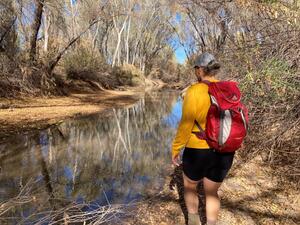The Fall 2024 Binational Beaver Survey Methods & Results
Read the full report here
Exciting News!
 We have completed our fourth and most extensive annual bi-national beaver survey on the San Pedro River! Previously, we had only surveyed sections of the upper San Pedro River within the San Pedro Riparian National Conservation Area (SPRNCA), managed by the Bureau of Land Management (BLM). This past year, we expanded our efforts by to include sections of the middle and lower San Pedro River from downstream of Benson, AZ to Mammoth, Az. In total, 120 volunteers helped us survey 77.5 river miles from Sonora, Mexico to Mammoth, Arizona, by recording recent signs of beaver activity such as dams, lodges, tracks and tree chews.
We have completed our fourth and most extensive annual bi-national beaver survey on the San Pedro River! Previously, we had only surveyed sections of the upper San Pedro River within the San Pedro Riparian National Conservation Area (SPRNCA), managed by the Bureau of Land Management (BLM). This past year, we expanded our efforts by to include sections of the middle and lower San Pedro River from downstream of Benson, AZ to Mammoth, Az. In total, 120 volunteers helped us survey 77.5 river miles from Sonora, Mexico to Mammoth, Arizona, by recording recent signs of beaver activity such as dams, lodges, tracks and tree chews.
Our Beavers' Tale:
Beavers once thrived in the rivers of southeastern Arizona but were extirpated over 100 years ago due to extensive trapping. In an effort to restore this keystone species and the vital ecosystem services they provide, the Bureau of Land Management reintroduced beavers to the San Pedro River. Since 2021, Watershed Management Group and our partners have been monitoring the beaver population through annual bi-national surveys.
Here's a brief overview of the results:
Population Estimate: The Fall 2024 survey estimates that there are approximately 30-38 beavers present along the San Pedro River. Of this total, an estimated 13-17 beavers were present in surveyed sections in Sonora, while 17-21 beavers were present in Arizona. Within Arizona the upper San Pedro River in the SPRNCA had an estimated 9 beavers, while the middle and lower San Pedri had 8-12 beavers. These results highlight a continued trend of a declining beaver population along the San Pedro River.
For more detailed information, you can access the full Fall 2024 Bi-National Beaver Survey Report here
What Does This Mean?
The declining beaver population is concerning, as beavers play a vital role in supporting healthy river ecosystems. Factors such as fluctuating water levels during monsoon seasons and increased predation by local species may be contributing to this decline. Continued monitoring, research, and community engagement are essential to address these challenges.
Looking Ahead:
WMG's "Release the Beavers" campaign aims to support beaver reintroduction, enhance local ecosystems, and improve habitats for native species. In an exciting development, WMG is initiating an AZ Statewide Beaver Working Group. This Working Group aims to bring together partner organizations and agencies throughout the state to establish collaboration on beaver related management, policy, and education.
Get Involved:
Join the River Run Network to stay updated on our "Release the Beavers" campaign and future restoration efforts. Together, we can make a difference in restoring our river ecosystems. Be the Beaver!
Acknowledgments:
We extend our gratitude to the dedicated community science volunteers, partner organizations, and funding partners, including The Nature Conservancy and National Park Service Southwest Border Protection Program. Special thanks to co-authors Nadira Mitchell, Restoration Ecology Apprentice and Brenai Smith Shires, Restoration Ecology Apprentice for their invaluable contributions to the fall 2024 survey.
Land and Water Acknowledgment:
Watershed Management Group acknowledges that we live, learn, work, and engage with the community on the ancestral lands of the Hohokam and Sobaipuri, and those of the Apache, Pascua Yaqui, and Tohono O’odham, whose relationship with this land continues to this day. Learn more about the Indigenous communities and the history of the land at www.native-land.ca





